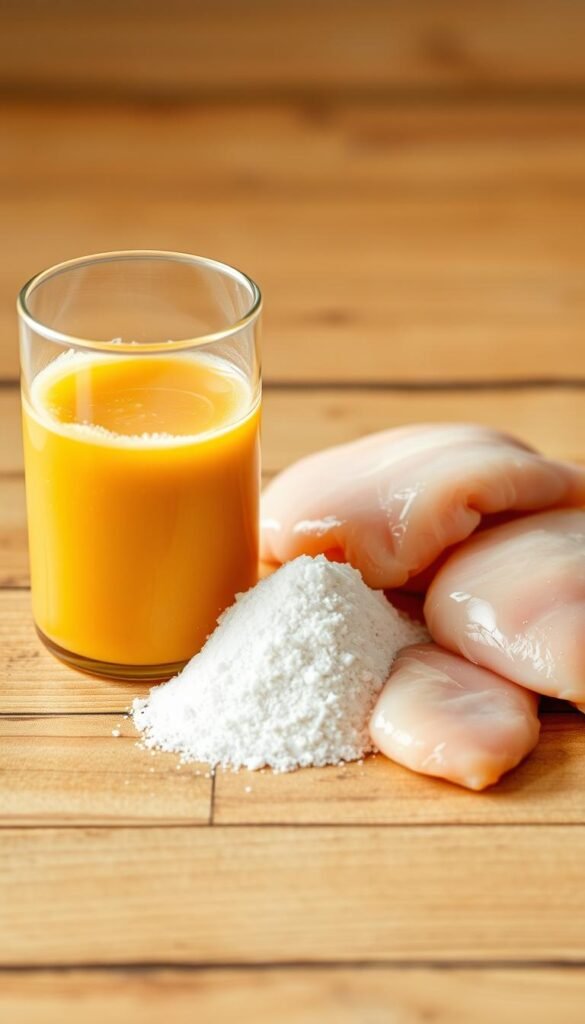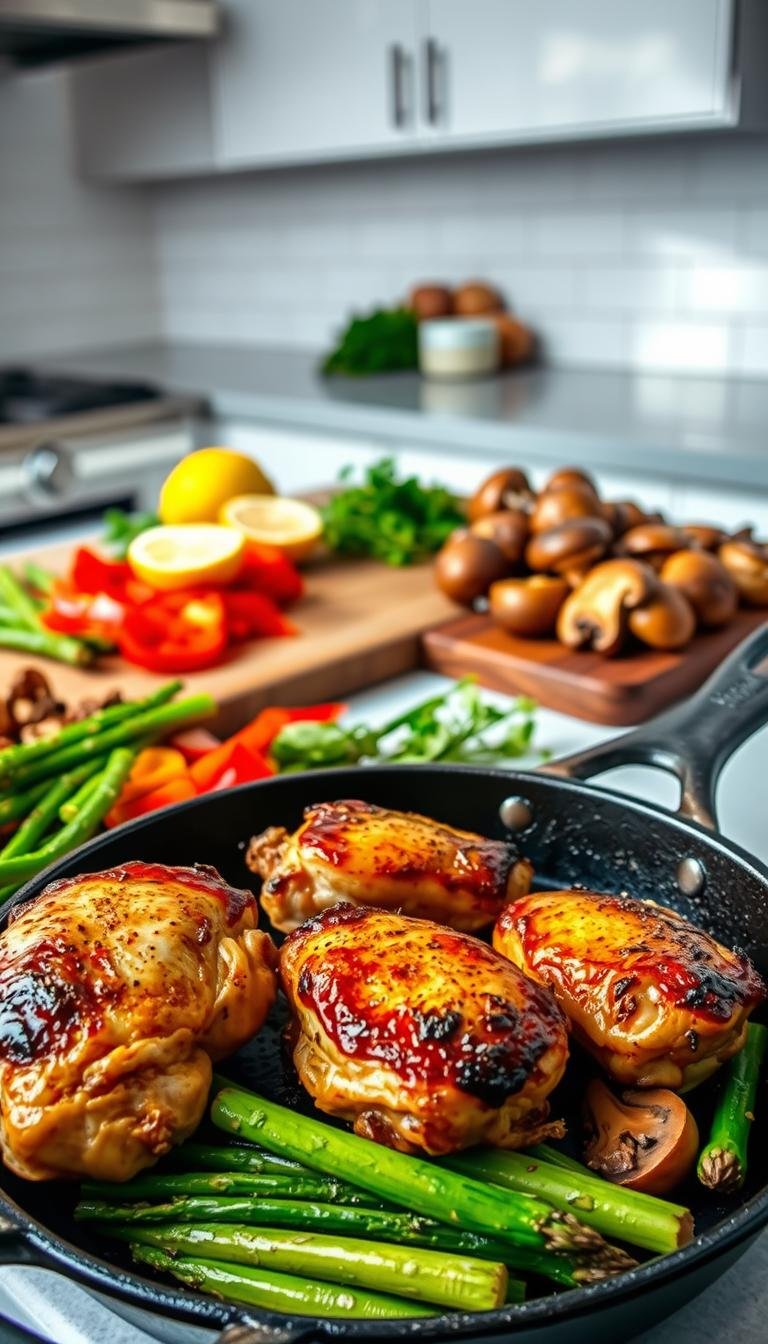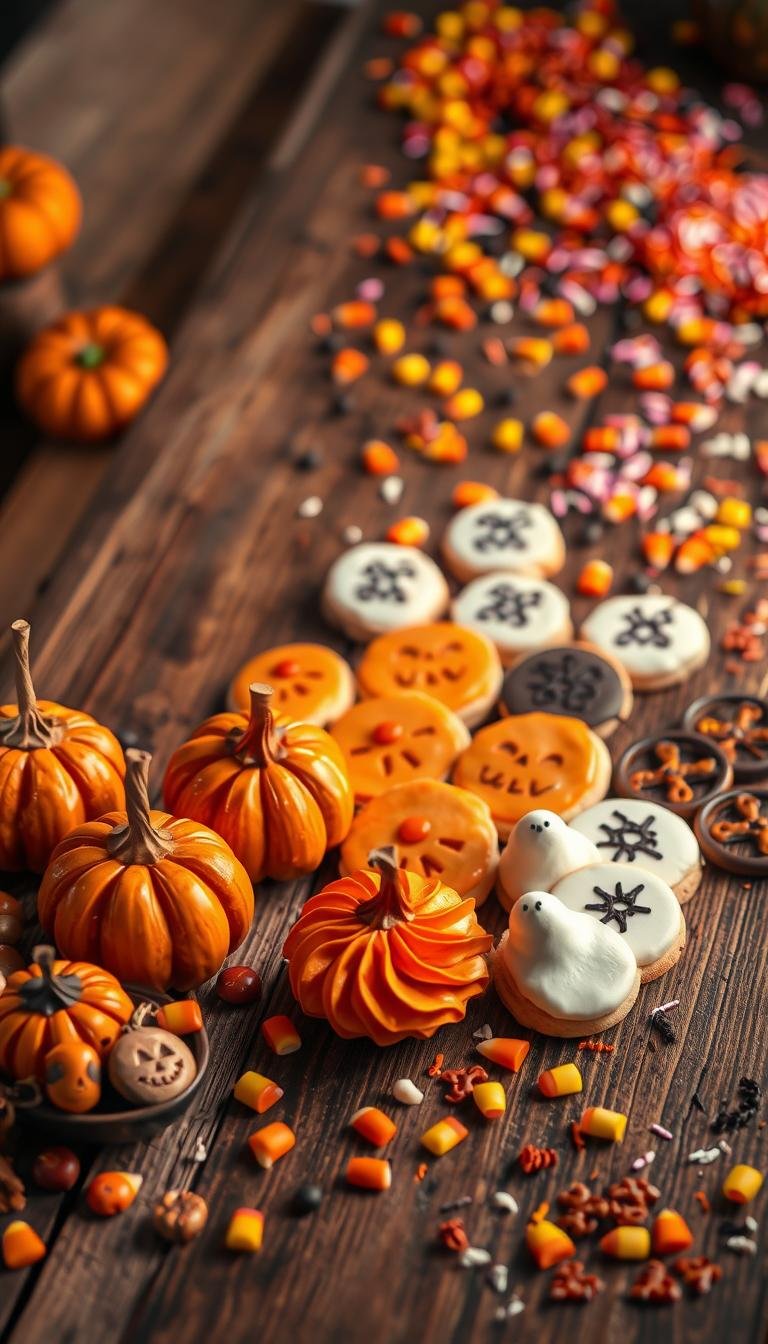Dinner Ideas with Chicken: Quick & Easy Recipes
Surprising fact: nearly 60% of home cooks say a one-skillet meal saves them at least 20 minutes on busy weeknights.
This guide pairs speed and flavor so you can get a full meal on the table fast. We spotlight two stovetop hits: a creamy Marry Me chicken with sun-dried tomatoes and a 15-minute Honey Garlic chicken that uses five main ingredients.
Expect clear calls on ingredients, why each one matters, and smart swaps that keep quality high. You’ll also get storage and reheating notes to turn tonight’s plate into tomorrow’s lunch without guessing.
Practical tips cover heat control, sauce reduction, and one-pan tricks that prevent overcooking. By the end, you’ll know which recipe fits your time and pantry so you can cook with confidence.
Key Takeaways
- Two fast stovetop recipes: creamy Marry Me and 15-minute Honey Garlic.
- One-pan methods and smart shortcuts save time and cleanup.
- Ingredient callouts explain swaps and why they matter.
- Make-ahead and reheating tips for easy leftovers.
- Simple sides and protein-forward notes balance richness.
Quick dinner inspiration for busy weeknights
Scan total cook time and ingredient count first to choose a fast, reliable skillet meal.
Pick recipes that match available minutes and pantry staples. Small cuts of chicken speed cooking and cut prep time.
Preheat the pan and lay out ingredients. This keeps sauce from over-reducing and helps steps flow.
Keep sides simple: steamed rice, a microwaveable pouch, or a quick-cooking vegetable finish the plate fast.
“Stack tasks: wash and chop while the pan heats and the rice cooks in the background.”
- Stir sauces in a small bowl while chicken sears to keep timing tight.
- Lean on garlic and a concentrated sauce for bold flavor in less time.
- Use a lid to manage splatter and speed simmering when needed.
| Side | Time | Why it works |
|---|---|---|
| Steamed rice | 12–15 minutes | Soaks up sauce and requires little hands-on attention |
| Microwave veg pouch | 3–5 minutes | Fast, consistent, and keeps veggies bright |
| Quick sautéed greens | 4–6 minutes | High flavor, low prep, pairs with bold sauces |
Pantry and fridge staples to make chicken dinners fast
Stock smart, cook faster. Keep a short list of reliable ingredients on hand so a weeknight skillet cooks up quickly and tastes intentional.
Olive oil, salt, pepper, and garlic: flavor foundations
Start with good olive oil to sear and build browning in a hot pan. Add minced garlic after searing so it blooms but does not scorch.
Season early and again at the end—lightly with salt and pepper—so layers of flavor develop. A quick quote to remember:
“Season in stages: once before the pan, once to finish the sauce.”
Chicken breasts vs. thighs: cook time and texture
Sliced chicken breasts or small cubes cut cook much faster than whole pieces. Thighs are more forgiving but need a few extra minutes.
Use a light flour dredge to coat chicken when you want a touch of thickness in a cream sauce. Keep dried oregano and a wedge of parmesan cheese nearby for quick Italian-style finishes.
- Portion and freeze flat for fast thawing.
- Choose a heavy pan to avoid crowding and steaming.
- Store sun-dried tomatoes, stock, and cream alternatives to pivot a simple recipe into a restaurant-style plate.
Marry Me Chicken: creamy skillet chicken with sun-dried tomatoes
Build a silky, savory sauce around seared cutlets for a restaurant-style Marry Me in one pan.
Ingredients that build flavor: heavy cream, grated parmesan cheese, oregano, thyme, chili flakes, and chicken stock form the base. Use oil from sun-dried tomatoes to deepen flavor and a touch of butter for browning.
Step-by-step in one pan
Slice three large chicken breasts into thin cutlets. Season with salt and pepper, then dredge in flour to coat chicken and encourage browning.
Heat olive oil and butter in a skillet. Brown cutlets 4–5 minutes per side; hold on a plate.
Sauté three minced garlic cloves briefly. Deglaze with one cup chicken stock, then lower heat and add one cup heavy cream and 1/2 cup grated parmesan cheese. Simmer until the sauce begins to thicken, stir in 1/3 cup sun-dried tomatoes and herbs, return the cutlets, and finish with chopped basil.
Pro tips and storage
- Coat chicken in flour to help thicken sauce and improve crust.
- Avoid half-and-half; it won’t thicken properly.
- Add a squeeze of lemon off heat to lift richness.
- Store up to 3 days refrigerated and reheat in the microwave or oven with a splash of water to loosen the sauce. Serve over rice or a simple green side.
15-minute Honey Garlic Chicken: five ingredients, big flavor
A quick honey-garlic glaze transforms small cubes into a saucy, satisfying skillet meal in about fifteen minutes. This recipe uses pantry staples and a hot pan to deliver bright, sticky flavor fast.
Sticky-sweet glaze components
Mix: honey, low-sodium soy sauce, minced garlic, and a pinch of red pepper flakes. The balance of sugar and soy keeps the taste bold while controlling sodium.
Fast method
Heat 2 tsp olive oil in a large skillet over medium-high. Season 1.5 lb cubed boneless, skinless chicken breasts lightly with salt and black pepper and brown 3–4 minutes.
Whisk 3 tbsp honey, 3 tbsp low-sodium soy sauce, 3 minced garlic cloves, and 1/4 tsp red pepper flakes. Add to the pan and toss; cook 4–5 more minutes until cooked through.
Thicken sauce without dredging
For a glossy finish, stir a slurry of 1–3 tsp cornstarch mixed with 1 tbsp water into the pan in the last 1–2 minutes.
Top and serve
Serve over steamed rice and top with sliced green onions, sesame seeds, chopped peanuts, or a lime wedge for bright contrast.
“Small pieces sear fast—pull them as soon as they’re cooked to preserve juiciness.”
- Cut even cubes so searing takes only minutes and the glaze coats every side.
- Low-sodium soy sauce reduces overall sodium while keeping savory depth.
- Store leftovers up to 4–5 days and reheat in the microwave or a skillet with extra sauce so the glaze loosens.
dinner ideas with chicken you can make in one pan
One-skillet meals cut steps and cleanup, so you can sear, simmer, and serve from a single pan. This method keeps flavor focused and gets a full plate on the table fast.
Skillet wins: sear, simmer, and thicken sauce
Start by searing evenly sized pieces to build fond. Deglaze the pan with stock or wine, then reduce to concentrate flavor.
Tip: Stir in a cornstarch slurry or return the chicken to thicken the sauce so every bite carries sauce and browning.
Rice and vegetables: easy sides for a complete meal
While the sauce reduces, let rice cook hands-off and steam or sauté a quick vegetable as a bright side. This keeps the plate balanced without extra pots.
Oven assist: keep chicken warm while finishing sauce
If the protein finishes earlier, nestle pieces in a low oven (about 200°F) to hold warmth. Finish the sauce on the stovetop, then return the chicken just before serving.
- Keep a tablespoon of olive oil to refresh the pan and bloom aromatics.
- Add a pinch of oregano or a shower of parmesan cheese at the end for instant lift.
- Use a large pan to avoid crowding so breasts or sliced chicken breasts brown evenly in minutes.
“Sear, aromatics, deglaze, enrich, return, and finish — repeat this flexible structure across recipes to save time and boost flavor.”
Nutrition notes: protein, fat, and sodium
A quick check of protein, fat, and sodium helps you balance flavor and health.
Aim for balanced plates. Pair protein-rich chicken with a generous portion of vegetables and a modest starch. This keeps meals satisfying and helps control added fat from creamy sauce.
Portion size matters. If a sauce is rich, use a smaller serving and add lemon to brighten the plate. A squeeze of lemon and cracked pepper can lift flavor without extra salt.
Lower-sodium swaps and seasoning tips
Choose low-sodium soy sauce for sweet-savory glazes and taste before adding extra salt. If a sauce tastes flat, try lemon or fresh herbs first.
- Watch reductions in a pan; add stock or water to avoid over-concentrating sodium.
- Check condiment labels for added sugar and adjust other seasonings to balance sweet notes.
- Measure oils and finishers if you track macros; sauces add fat quickly.
How the recipes fit daily needs
Both recipes deliver solid protein per serving and work well for an evening meal. Adjust fats and finishes to match your goals without losing core flavor.

| Element | Tip | Quick impact |
|---|---|---|
| Protein | Pair 3–4 oz chicken with veg | Filling, supports muscle recovery |
| Fat | Limit rich sauce portions; add lemon | Reduces calories, keeps flavor |
| Sodium | Use low-sodium soy and taste first | Controls blood pressure load |
“A well-seasoned, moderate portion with vegetables fits most weeknight routines.”
Time-saving strategies you’ll use tonight
Cutting protein into thin pieces and planning each step shaves minutes off prep and cook time. A small change at the start can speed the whole process and reduce stress at plating.
Prep and cook
Slice a chicken breast into thin cutlets or small cubes so searing is fast and doneness is easy to judge. Use a wide skillet to avoid crowding and to speed evaporation when a sauce needs to thicken.
Make-ahead moves
Keep pre-minced garlic and grated cheese in the fridge so you can jump straight into cooking. Prep rice ahead or use microwaveable pouches to serve as soon as the pan is ready.
- Organize ingredients on the counter before heat—this reduces pauses while you cook.
- Add chicken to a preheated pan for an immediate sear that locks in juices.
- Make sure to measure core ingredients so you can whisk a sauce while the protein browns.
- Keep a small amount of oil handy to refresh the pan if things start to stick.
| Task | Why it saves time | When to do it |
|---|---|---|
| Slice into cutlets/cubes | Seared pieces cook faster and more evenly | Before heating the pan |
| Pre-minced garlic & grated cheese | Eliminates chopping/grating during the recipe | Store in fridge, use all week |
| Batch-cook rice | Portion-ready sides cut plate assembly time | Cook once, use for several meals |
Pro cooking tips for juicy chicken and perfect sauce
A few timed moves at the stove keep meat juicy and the sauce silky every time.

Make sure to not overcook: internal temp and carryover cooking
Use an instant-read thermometer and make sure to pull the meat as it reaches target doneness. Carryover cooking will raise the internal temp a few degrees while the sauce finishes.
If you finish in the oven, keep heat low to hold warmth without overcooking.
Thicken sauce the right way: flour dredge vs. cornstarch slurry
For a creamy recipe, a light flour dredge on the breast helps thicken as the sauce simmers.
For glossy, quick glazes, stir a cornstarch slurry (1–3 tsp cornstarch + 1 tbsp water) into the pan in the last 1–2 minutes to thicken sauce fast.
Coat evenly and brown well for better flavor
Pat pieces dry, then season with salt and pepper in layers. Add chicken to a fully preheated pan so browning starts immediately.
Resist moving the meat until a golden crust forms; that fond builds the best base for your sauce.
Avoid curdling: acid, whisking, and rescue steps
When using dairy, add lemon off heat to prevent curdling. If the sauce separates, remove the meat and whisk the sauce vigorously to bring it back together.
If the sauce over-reduces, loosen it with a splash of chicken stock and simmer briefly. Mince cloves evenly so garlic cooks without burning.
“Pull meat at temperature, not time; finish the sauce gently and your plate will sing.”
| Problem | Quick fix | Why it works |
|---|---|---|
| Overcooked meat | Pull at temp; rest 5 minutes | Carryover retains juices, prevents dryness |
| Thin sauce | Return chicken or add slurry | Thickens without changing flavor |
| Curdled cream | Add lemon off heat; whisk | Prevents separation and restores texture |
Conclusion
Use a single pan and a few bright finishers to turn pantry staples into a reliable chicken dinner that fits real schedules.
Choose the fast honey-garlic recipe when you need a meal in minutes, or make the creamy sun‑dried tomato dish when time allows for richness. A good pan, oregano, and a sprinkle of parmesan cheese lift basic ingredients to a special dish.
Prep before you heat, lean on the oven briefly if you must hold plates, and top servings with sauce and a squeeze of lemon. Save or print your favorite recipe and practice the techniques—speed and confidence grow with every weeknight cook.






